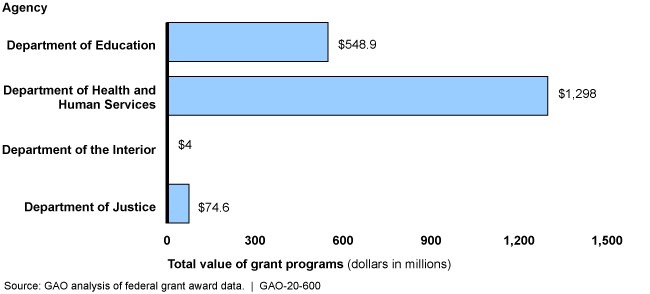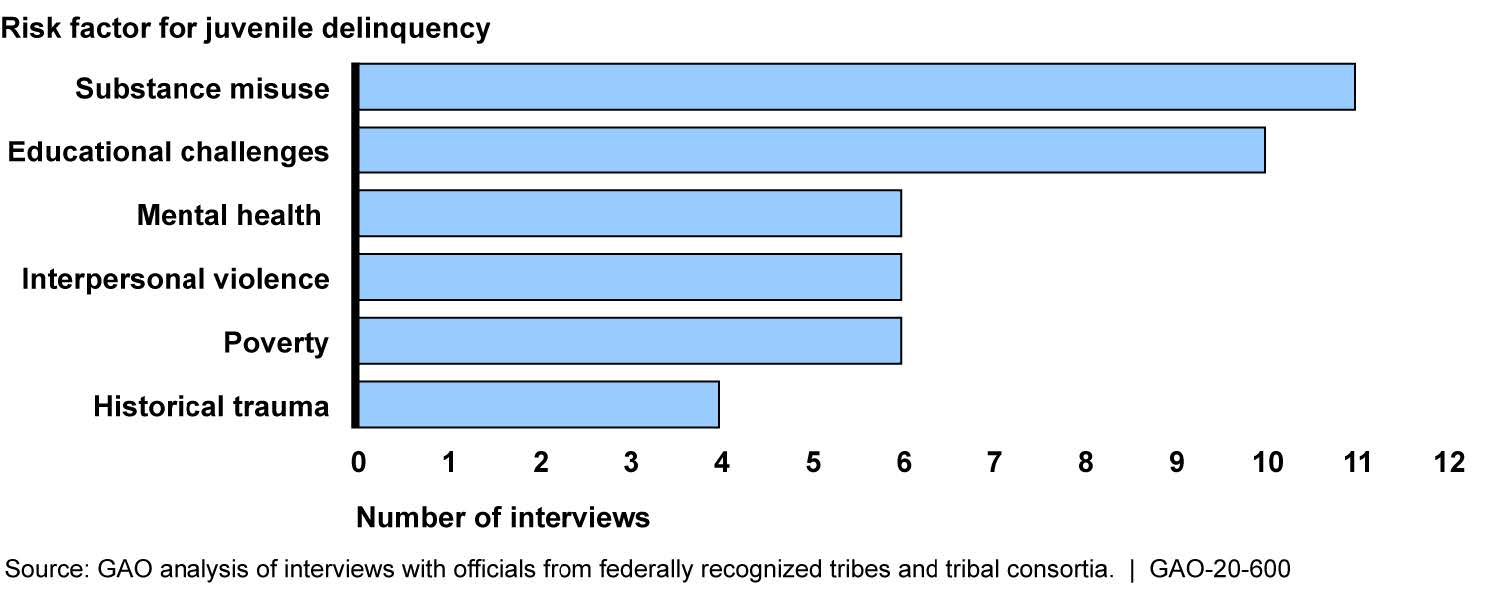Native American Youth: Agencies Incorporated Almost All Leading Practices When Assessing Grant Programs That Could Prevent or Address Delinquency [Reissued with revisions on Aug. 27, 2020.]
Fast Facts
Studies have noted that historical trauma, exposure to violence, and substance abuse make Native American youth susceptible to becoming involved with the justice system.
Four federal departments administered at least 38 grant programs (and about $1.9 billion) that could help prevent or address delinquency among Native American youth between FYs 2015-2018.
These departments incorporated several leading practices to assess the performance of their grant programs. We made 3 recommendations that could help some of these departments further assess the reliability and timeliness of reports.
Value of Selected Grant Programs That Could Help Prevent or Address Tribal Juvenile Delinquency, Fiscal Years 2015-2018

Reissued August 27, 2020 to correct the Figure 1 map and title on page 9 of the background section by removing the shading and figure note that inaccurately described certain areas as Indian country and clarifying the source of the Native American population data.
Highlights
What GAO Found
The Departments of Justice (DOJ), Health and Human Services (HHS), the Interior (Interior), and Education (Education) administered at least 38 grant programs from fiscal years 2015 through 2018 that could have helped prevent or address delinquency among Native American youth. These agencies made about $1.9 billion in awards to grantees through these programs during this period.
These agencies incorporated almost all of the leading practices GAO identified for performance measurement or program evaluation when assessing the performance of selected grant programs. For example, HHS's Administration for Children and Families (ACF) incorporated 13 of the 14 leading practices for performance measurement but did not fully assess grantee data reliability for one of its programs. By developing a process to assess the reliability of grantee data contained in the annual performance reports that tribal recipients submit, ACF could obtain further assurance that it has an accurate representation of grantee performance. GAO also found that Interior's Bureau of Indian Education (BIE) did not conduct formal data reliability checks on performance data that grantees report and did not always collect performance reports from grantees in a timely manner for one of its programs. By developing a process to assess the reliability of a sample of grantee performance data and taking steps to alert grantees when they are late in submitting performance reports, BIE could better ensure that grantees are complying with the terms and conditions of the grant program and better understand how the program and its grantees are performing.
Officials in all 12 interviews with tribes or tribal consortia GAO interviewed cited risk factors that contribute to juvenile delinquency in their communities.
Number of Interviews in Which Tribal Officials Cited Risk Factors Contributing to Juvenile Delinquency

Note: The figure includes the most common risk factors tribal officials cited for juvenile delinquency.
While tribal officials cited restrictions placed on federal grant funding, difficulty communicating with program staff, and challenges hiring and retaining staff as barriers to implementing federal programs, they also identified promising practices, such as executing culturally relevant programs, for preventing or addressing juvenile delinquency.
Why GAO Did This Study
Federal and other studies have noted that exposure to violence and substance abuse make Native American youth susceptible to becoming involved with the justice system. GAO was asked to examine federal and tribal efforts to address juvenile delinquency and the barriers tribes face in doing so.
This report examines (1) federal financial assistance targeting tribes that could prevent or address juvenile delinquency; (2) the extent to which federal agencies assess the performance of selected grant programs and incorporate leading practices; and (3) the juvenile delinquency challenges tribes report facing. GAO identified relevant grant programs during fiscal years 2015 through 2018—the most recent data available when GAO began the review. GAO analyzed documents and interviewed agency officials to determine how they assessed grant program performance and conducted interviews with 10 tribes and two tribal consortia to discuss challenges with delinquency.
Reissued with revisions on Aug. 27, 2020.
Reissued August 27, 2020 to correct the Figure 1 map and title on page 9 of the background section by removing the shading and figure note that inaccurately described certain areas as Indian country and clarifying the source of the Native American population data.Recommendations
GAO is making three recommendations, including that relevant HHS and Interior offices develop a process to assess the reliability of tribal grantee performance information and that an Interior office take steps to alert grantees that are late in submitting progress reports. Interior concurred with the two recommendations. HHS disagreed with GAO's recommendation. GAO clarified the recommendation to HHS and continues to believe it is warranted.
Recommendations for Executive Action
| Agency Affected | Recommendation | Status |
|---|---|---|
| Administration for Children and Families | The Associate Commissioner of the Administration for Children and Families Children's Bureau within the Department of Health and Human Services should develop a process to assess the reliability of grantee performance information contained within annual performance reports for tribal recipients of its Stephanie Tubbs Jones Child Welfare Services Program. (Recommendation 1) |
In November 2021, officials from HHS's Children Bureau within its Administration for Children and Families (ACF) told us that its joint planning process with tribes for its Stephanie Tubbs Jones Child Welfare Services Program is consistent with the level of burden they can impose on grantees to receive funding. In response, we acknowledged that if ACF officials determine that performance information is incomplete or inaccurate in the course of assessing the reliability of grantee performance information contained within annual performance reports, then they indeed would likely need to follow up with tribal recipients for remediation. We stated, however, that the benefits of developing such a process in terms of having increased visibility of tribal recipients' data collection practices and program performance as well as gaining insight about the possible need for technical assistance to those who are struggling in this area outweigh the potential burden of following up with tribal recipients whose performance information contained within the Annual Progress and Services Reports is found by ACF officials to be incomplete or inaccurate in some way. Additionally, in HHS's most recent FY 2022 Good Accounting Obligation in Government Act Report, whose content HHS last reviewed March 13, 2023, HHS stated that ACF continues to non-concur/disagree with this recommendation. We followed up with HHS in May, 2024 and in May, 2025. As of May, 2025, ACF confirmed that it continues to non-concur with this recommendation.
|
| Bureau of Indian Education | The Director of the Department of the Interior's Bureau of Indian Education should take steps to alert grantees of the Native Language Immersion Cooperative Agreement when they are late in submitting performance reports. (Recommendation 2) |
In April 2021, Interior officials sent GAO the 180-day letter that included a summary of actions taken or planned to implement the recommendations. For this recommendation, the letter stated, "as the Native Language Immersion Cooperative Agreement program matures and the SIE Office continues to fill critical positions, the BIE anticipates that the issue of timely and regular performance reporting will be addressed." The letter included an estimated implementation date of September 30, 2022. Since the 180-day letter, we have followed up for status updates in November 2021, April 2022, April and May, 2023, May, 2024 and May, 2025. We will provide more information as soon as it becomes available.
|
| Bureau of Indian Education | The Director of the Department of the Interior's Bureau of Indian Education should develop a process to assess the quality and reliability of a sample of grantee performance data for the Native Language Immersion Cooperative Agreement. (Recommendation 3) |
: In April 2021, Interior officials sent GAO the 180-day letter that included a summary of actions taken or planned to implement the recommendations. For this recommendation, the letter stated that the BIE "Performance Office will be tasked with assisting the SIE Office in inventorying, reviewing and improving data collection and analysis. As part of this work, the BIE anticipates that the Native Language Immersion Cooperative Agreement program will develop a process to assess the quality and reliability of data." The letter included an estimated implementation date of September 30, 2022. Since the 180-day letter, we have followed up for status updates in November 2021 and April 2022, April and May, 2023, as well as more recently in May, 2024 and May, 2025. We will provide more information as soon as it becomes available.
|
